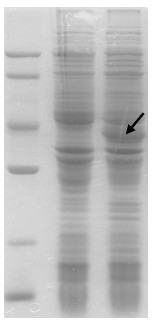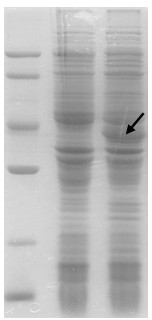Preparation method and application of recombination ryegrass pollen allergen and mutant thereof
A technology for pollen allergy and ryegrass, applied in the field of genetic engineering, can solve the problems of complex components and increase the possibility of allergic reactions, and achieve the effect of reducing binding performance and reducing allergenicity
- Summary
- Abstract
- Description
- Claims
- Application Information
AI Technical Summary
Problems solved by technology
Method used
Image
Examples
Embodiment 1
[0035] Example 1 Cloning and expression of recombinant ryegrass pollen allergen
[0036] (1) Determination of the nucleic acid sequence of the recombinant ryegrass pollen allergen: Obtain the nucleic acid sequence of the natural ryegrass pollen allergen (GenBank accession number: L13083.1) from the NCBI database, and add a conveniently purified parent And tag 6*HIS, STREPII or S protein. Then Nde I, Eco RI, Xho I, Pst I and other enzyme cutting sites were added to the N-terminus and C-terminus of the sequence respectively to obtain the target gene fragment Q4DF of the recombinant ryegrass pollen allergen.
[0037] (2) According to the codon preference of Escherichia coli, the nucleic acid sequence of the target gene Q4DF was codon-optimized to make the target gene more suitable for expression in the host bacteria. After optimization, the GC content was 35-65%, and the original amino acid sequence remained unchanged. , as shown in SEQ ID NO:1.
[0038] (3) Synthesize the op...
Embodiment 2
[0045] Example 2 Antigen epitope analysis and mutation site determination of recombinant ryegrass pollen allergen
[0046] (1) Using online software platforms including SYFPEITHI, MHCPred, SYFPEITHI, BIMAS, NetMHCⅡ, MHC-THREAD, EpiPredict, HLA-DR4 binding, ProPred, RankPep, SVMHC, PREDEP, PREDICT, etc. to analyze the amino acid sequence of the recombinant ryegrass pollen allergen Antigen index was analyzed. Based on the analysis of various software, the results showed that the antigenic value of the 1-25, 69-89, 301-323 regions in the amino acid sequence of the recombinant ryegrass pollen allergen was higher.
[0047] (2) Carry out amino acid substitutions for one or more sites with relatively high antigenic value to weaken the antigenicity. The above-mentioned antigenicity analysis is performed on the amino acid sequence after antigenic modification, and so on, and the mutation sites with significantly reduced antigenicity are screened out.
Embodiment 3
[0048] Example 3 Construction of recombinant ryegrass pollen allergen mutants
[0049] (1) For the identified mutation site, design mutant primers according to the method provided by the mutation kit. The Tm value is generally required to be greater than 78°C, and the primer length is more suitable between 25-45 bases.
[0050] (2) According to the requirements of the mutation kit, the recombinant expression plasmid of the recombinant ryegrass pollen allergen was used as a template for mutation PCR.
[0051] (3) After digesting the PCR product with the enzyme provided in the kit, transform the competent cells, pick positive clones, and sequence to check whether the mutation is successful.
PUM
 Login to View More
Login to View More Abstract
Description
Claims
Application Information
 Login to View More
Login to View More - R&D
- Intellectual Property
- Life Sciences
- Materials
- Tech Scout
- Unparalleled Data Quality
- Higher Quality Content
- 60% Fewer Hallucinations
Browse by: Latest US Patents, China's latest patents, Technical Efficacy Thesaurus, Application Domain, Technology Topic, Popular Technical Reports.
© 2025 PatSnap. All rights reserved.Legal|Privacy policy|Modern Slavery Act Transparency Statement|Sitemap|About US| Contact US: help@patsnap.com


